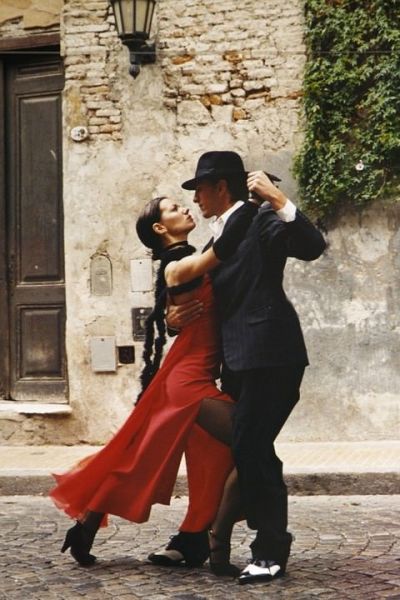Il tango è oggi un ballo popolare associato ad incanto ed eleganza, sebbene ai suoi inizi fosse molto differente. Cominciò a diffondersi a Buenos Aires - la città dove “far fortuna” intorno al 1820, come tipo di percussione usata dagli afroamericani. La grande disponibilità di manodopera attirò presto immigrati Italiani, Francesi, Ungheresi, Ebrei e Slavi, che si unirono a schiavi liberati e Argentini della seconda e terza generazione, con cui convivevano in squallidi quartieri costruiti dal nulla, creando una miscela unica e irripetibile di tradizioni etniche e culturali che è diventata l’ingrediente magico di un processo creativo. Se da una parte le canzoni cantavano un’esperienza comune di tristezza, felicità e gioie, di nostalgia e distanza, di speranze ed aspirazioni, di solitudine, lealtà e fratellanza nell’avversità, la struttura armonica del tango è tipicamente italiana e buona parte del suo peso culturale è originario dell’Italia. I nomi, infatti, dei maggiori compositori di musica a partire dai primi anni del Novecento fino all’età d’oro del tango, quella degli anni ’30 e ’40, sono tutti figli di immigrati italiani.
What do you think of when you hear the words Argentine Tango? You may visualize hot, dark, smoke-filled dancehalls with intense men scanning the room for their next dance partner, or movies like “Last Tango in Paris” or the dance scene in “Scent of a Woman.”
The tango intrigued me and in the late 1990’s I decided to learn this dance and found myself in the basement of a church in Old Brooklyn, OH with members of the Western Reserve Argentine Tango Society. With that first lesson, I was transported to another world and found myself entranced with the Argentine Tango. As a first generation Italian American, I was exposed to and developed a love of classical opera and Neapolitan love songs, but this sound and style of dance was foreign to me. Tango music is a mix of styles: polkas, waltzes, milongas – Argentine folk music which combined indigenous rhythms with music of the early Spanish colonists, the habanera of Cuba, and candombe rhythms of Africa.
I was curious as to why many of the musicians, composers and dancers had Italian names and wondered about tango’s connection to Italy. The political and social upheaval following Italy's unification in 1871 coupled with Argentina’s independence from Spain encouraged Italians to emigrate there, the majority settling in and around Buenos Aires as well as in Brazil and Uruguay. Up to two-thirds of Argentines claim Italian ancestry.
The connections to Italian culture in terms of language, customs and traditions are significant. Italians greatly impacted the development of the tango as they brought with them their melodies and style of dance along with their instruments: violin, piano, guitar, and accordion. The harmonic structure came from Italian opera and Neapolitan canzonetta with its themes of love and betrayal. At one time it was said that tango had become an “all-Italian business” because of the large numbers of Italian singers, composers, producers, and promoters, as well as dancers who brought tango’s music to the streets.
Jose Libertalla of Italy, maestro of the bandoneon (Argentine accordion), said “Tango started in brothels and the poorest sections of town. It is the music of immigrants. It is of emotional people going through emotional times.” Musicians such as “the father of tango” Carlos Gardel, Carlos di Sarli and the magnificent composer Astor Piazzola all made major contributions to the tango. Enrique Santos Discepolo, son of an Italian immigrant, said, “Tango is a sad thought that you can dance.” The sentimentality that flows from the tango melody comes from the immigrants’ nostalgia and longing for their homeland and families.
The music as well as the social structure of the tango changed with new generations of musicians, with major transformations taking place in the late ‘30s into the ‘50s. In the ‘90s, stage productions such as “Forever Tango” brought tango to America and Europe. Visiting Argentine tango dancers such as Pablo Veron, Milena Plebs, the Puglieses, the Zottos, and Susanna Miller began teaching workshops across the country igniting tango fever.
Despite the changes over the years, the basics of the dance remain. The milonguero (male dancer) using the cabeceo (the look and nod) signals an offer of dance to a woman, who, if agreeable, returns the nod. Thus begins the tango with dancers in tango embrace, balancing on their own axes, moving in unison, cognizant of the music, the dance floor and the other dancers. Tango is a dance of improvisation. There are countless numbers of patterns, steps and figures that can be improvised from the three basic moves: side, forward and back. The man uses subtle body movements to open a space for the woman to execute a step or a movement followed by the man. The posture, the embrace and the feline movements all contribute to the elegance and sensuality of the tango. Former dancer with “Forever Tango” Carlos Gavito described the tango as a way of walking in an embrace together as one.
The tango community has flourished over the years. In Cleveland, it has grown from one or two teachers in the late 90’s to the present where you can find a milonga (dance) or a tango lesson any night of the week in neighborhoods on the east and west sides. Every teacher brings their own sense of style to the class making each a unique experience. One thing they all have in common is a passion for tango and its distinctive musical style. If you attend any one of these classes, you will quickly see why “it takes two to tango!”
“Guys, to dance tango, you must listen to the heart of the woman.”
“The tango is a feeling that is danced.”
Cacho Dante, milonguero of Buenos Aires
https://www.lagazzettaitaliana.com/lifestyle/9225-it-takes-two-to-tango#sigProIdb45ed0fedd




